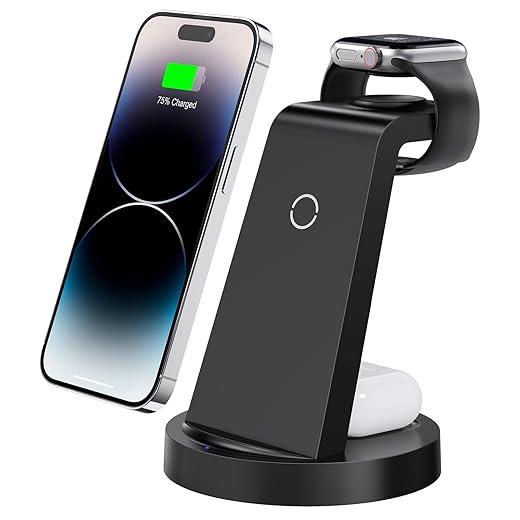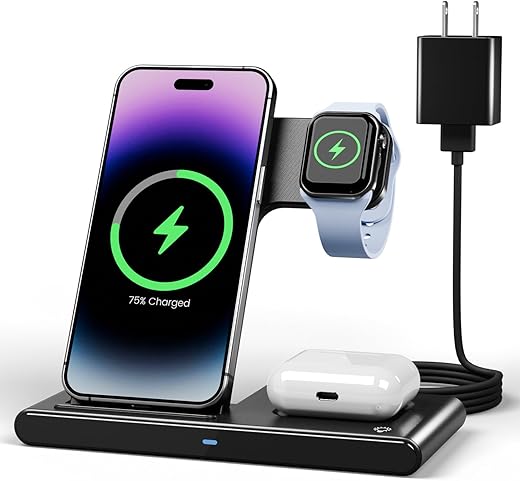





![EXW [2024] Upgraded Wireless Charger,3 in 1 Charging Station for Apple Devices,Wireless Charger Stand for iPhone 16 15 14 13 12 11 Pro Max XR XS 8,Apple Watch and AirPods(18W PD Adapter Not Included)](https://m.media-amazon.com/images/I/71vtl7p3gNL._SS520_.jpg)

Understanding Why Your Wireless Charger Isn’t Charging Your iPhone Properly
Wireless charging has become a staple in our fast-paced lives. The convenience of placing your iPhone on a pad and watching it charge without the hassle of tangled cords is undeniably appealing. However, many users find themselves frustrated when their wireless chargers fail to deliver the expected power. If you’ve ever wondered, “Why isn’t my wireless charger working as it should?” you’re not alone. Let’s explore the common reasons behind this issue and how you can resolve it.
1. Compatibility Issues
First and foremost, not all wireless chargers are created equal. While most modern chargers are designed to support a range of devices, some may not be fully compatible with your specific iPhone model. Apple’s iPhones typically support the Qi wireless charging standard, but you should always verify that your charger explicitly states compatibility with iPhones. Think of it like trying to fit a square peg in a round hole; it just won’t work.
2. Improper Alignment
Have you ever noticed that your phone doesn’t charge despite being placed on the charger? This could be due to improper alignment. Wireless charging relies on electromagnetic fields, and if your iPhone isn’t positioned correctly, it may not receive any power at all. Imagine trying to tune a radio to a specific station; if you’re just a little off, you’ll get static instead of music. Always ensure that your iPhone is centered on the charging pad for optimal charging.
3. Case Considerations
Many users love the extra layer of protection a case provides for their iPhones. However, some cases can hinder wireless charging. Thick cases, those made of metal, or even cases with magnetic components can block the charging process. When in doubt, remove the case and see if that resolves the issue. It’s like wearing a thick winter coat in a sauna—you won’t feel the warming effects!
4. Charger Quality
Not all chargers are built to the same standard. Cheaper, off-brand chargers may not deliver the same efficiency as their branded counterparts. They may also lack safety features that protect your device from overheating or overcharging. If your charger feels flimsy or cheap, it’s time to consider investing in a higher-quality option. Think of it like buying a budget pair of shoes; they might look good, but they won’t last long or provide the support you need.
5. Power Source Matters
The power source you use for your wireless charger can also impact its performance. If you’re plugging your charger into a low-power USB port or a weak power adapter, it may not provide enough energy to charge your iPhone efficiently. Always use a reliable power source, ideally one that matches or exceeds the charger’s specifications. Using a low-power source is like trying to fill a swimming pool with a garden hose; it’ll take forever!
6. Overheating Concerns
Wireless charging generates heat, which is a normal part of the process. However, excessive heat can deter charging or even damage your iPhone. If your device feels unusually warm while charging, it may be time to take a break. Ensure that both your charger and phone are in a well-ventilated area and not covered by any objects. Think of it as giving your iPhone a brief vacation; it needs some time to cool down!
7. Software Glitches
Sometimes, the issue isn’t hardware-related but rather a software glitch. If your iPhone isn’t charging wirelessly, try restarting the device. Software updates can also affect charging efficiency, so make sure you’re running the latest version of iOS. It’s akin to rebooting your computer when it’s acting sluggish; a fresh start can work wonders!
Conclusion
Wireless charging can offer unmatched convenience, but it’s not without its pitfalls. From compatibility issues to overheating concerns, understanding the nuances of wireless charging will help you enjoy a seamless experience with your iPhone. If you encounter charging woes, refer to this guide and troubleshoot accordingly. After all, technology should make our lives easier, not more complicated!
FAQs
1. Can I use any wireless charger for my iPhone?
While most modern wireless chargers support iPhones via the Qi standard, it’s essential to check for compatibility to ensure optimal performance.
2. What should I do if my iPhone gets hot while charging wirelessly?
If your iPhone feels excessively warm, remove it from the charger and let it cool down. Ensure both the charger and device are well-ventilated.
3. Do I need to remove my phone case for wireless charging?
In many cases, it’s advisable to remove thick or metallic cases, as they can interfere with the charging process. Test charging with and without the case to see what works best.
